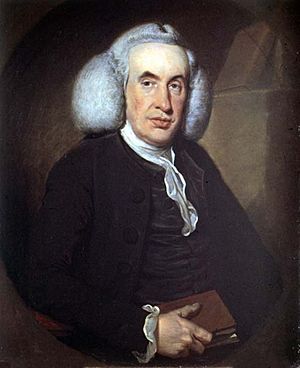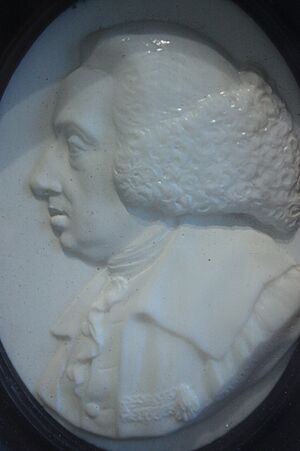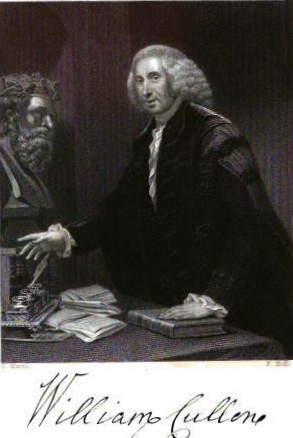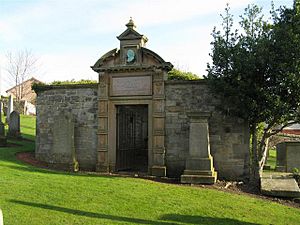William Cullen facts for kids
Quick facts for kids
William Cullen
|
|
|---|---|
 |
|
| Born | 15 April 1710 Hamilton, Lanarkshire, Scotland
|
| Died | 5 February 1790 (aged 79) Edinburgh, Scotland
|
| Alma mater | |
| Known for |
|
| Scientific career | |
| Fields |
|
| Notable students | |
William Cullen (15 April 1710 – 5 February 1790) was an important Scottish doctor, chemist, and teacher. He was a professor at the famous Edinburgh Medical School. Cullen was a key person during the Scottish Enlightenment, a time when new ideas in science and philosophy were very popular in Scotland.
He was a leader in several medical groups. He served as President of the Royal College of Physicians and Surgeons of Glasgow. Later, he became President of the Royal College of Physicians of Edinburgh. He was also the King's main doctor in Scotland for many years.
Cullen was a very popular teacher. Many of his students became famous doctors and scientists themselves. He stayed in touch with them, including Benjamin Rush, who helped found the United States. Another student, John Morgan, started the first medical school in the American colonies.
Cullen also wrote many medical textbooks. These books were very popular in Europe and America. His most famous book was First Lines of the Practice of Physic. He also helped invent the basic idea behind modern refrigeration.
Contents
Early Life and Education
William Cullen was born in Hamilton, Scotland. His father was a lawyer for the Duke of Hamilton. William went to the Old Grammar School of Hamilton. In 1726, he started studying at the University of Glasgow.
He began his medical training as an apprentice to a surgeon in Glasgow. Then, he worked as a surgeon on a ship that traveled between London and the West Indies. After this, he worked as an assistant in London.
In 1732, Cullen returned to Scotland. He started his own medical practice in Shotts and Hamilton. He even cured the Duke of Hamilton, who then became his supporter.
From 1734 to 1736, he studied medicine at the University of Edinburgh. Here, he became very interested in chemistry. He also helped start the Royal Medical Society.
Career in Glasgow
In 1736, Cullen started his medical practice in Hamilton. He quickly became well-known. He also kept studying natural sciences, especially chemistry.
In 1740, he earned his MD degree from Glasgow University. He married and started a family in 1741. He became the personal doctor to the Duke of Hamilton and his family.
After the Duke died in 1743, Cullen and his family moved to Glasgow. In Glasgow, he gave lectures at the university. He taught about how the body works, plants, medicines, and chemistry.
Cullen was a great teacher. He used practical demonstrations, which made his classes very popular. He also continued to work as a doctor. In 1747, he became Britain's first professor of Chemistry. He was also elected President of the Faculty of Physicians and Surgeons of Glasgow.
In 1748, while in Glasgow, Cullen came up with the basic idea for modern refrigeration. He showed how it could work, but it wasn't used for everyday purposes yet.
Moving to Edinburgh
In 1755, Cullen moved to Edinburgh to become a professor at the University of Edinburgh. In 1756, he gave the first public demonstration of artificial refrigeration. He used a pump to create a vacuum over a container of diethyl ether. This made the ether boil and absorb heat, creating a small amount of ice. However, this method was not used for business at the time.
From 1757, he taught about clinical medicine at the Edinburgh Royal Infirmary. He also wrote a new course on materia medica (the study of medical substances). This course was later published as A Treatise on Materia Medica in 1789.
Cullen became the sole professor of the practice of physic (medicine) in 1773. He held this important position until shortly before he died. In Edinburgh, Cullen lived near the old Scottish mint. He also had a country home in Kirknewton.
In 1783, Cullen helped found the Royal Society of Edinburgh. This was a very important scientific group. He was honored for his long service to the university in 1790.
William Cullen passed away at his home in Edinburgh on 5 February 1790. He is buried in the churchyard at Kirkliston. His son, Robert, is buried with him.
Cullen's Influence
William Cullen taught many students who became very important in British science. Many doctors who taught at Edinburgh's medical school in the late 1700s had studied with him. These included the chemist Joseph Black and the naturalist John Walker.
Cullen believed that chemistry had many practical uses. This made his ideas popular with farmers, factory owners, and doctors. His influence spread through the writings and lectures of his students.
Cullen also classified diseases by their symptoms. He grouped them into different categories. One group of diseases he called "neuroses," which related to the nervous system.
Medical Practice and Teaching
In the 1700s, there were three main types of medical professionals: physicians, surgeons, and apothecaries. William Cullen worked as all three. Since medical rules were not as strict then, doctors often needed good social skills to succeed. Cullen was very successful because he was good at dealing with patients. Teaching at the university and treating patients for free at the Edinburgh Infirmary also made him more famous.
Many of Cullen's patients wrote him letters from different towns. He would read these letters early in the morning. His assistant would then write and mail his responses. After that, he would visit patients in Edinburgh. Patients who wrote letters were usually from the upper and middle classes. Cullen also advised other doctors, often his former students. He was known for being a "tactful and compassionate practitioner."
Cullen was known for organizing and promoting medical knowledge. He taught for over 40 years. He believed in having a "system" for medical knowledge. This system helped students understand complex ideas. In the 1700s, many professors had different ideas about the human body and diseases. Cullen's system helped make sense of it all for his students.
Cullen was very interested in the nervous system. He called it an "animated machine" that helps the body move and interact with the world. He believed the nervous system had four main parts: the brain and spinal cord, nerves, sensory nerves, and muscles.
Cullen's ideas about the nervous system were influenced by other scientists. He believed that diseases were caused by an imbalance in how sensitive or active the nerves and muscles were. Based on this, his treatments aimed to either stimulate or calm the nervous system. He divided diseases into four main groups: fevers, nervous disorders, wasting diseases, and local problems.
Even though Cullen's specific way of classifying diseases did not last long, his teaching was very important. His efforts to organize and explain medical knowledge were a big part of the Scottish Enlightenment.
Family Life
In 1741, William Cullen married Anne (or Anna) Johnstone. She passed away in 1786.
He was the father of Robert Cullen, who became a judge, and Henry Cullen, who became a doctor. His eldest son, Robert, was known for his ability to imitate people.
See also
 In Spanish: William Cullen para niños
In Spanish: William Cullen para niños




